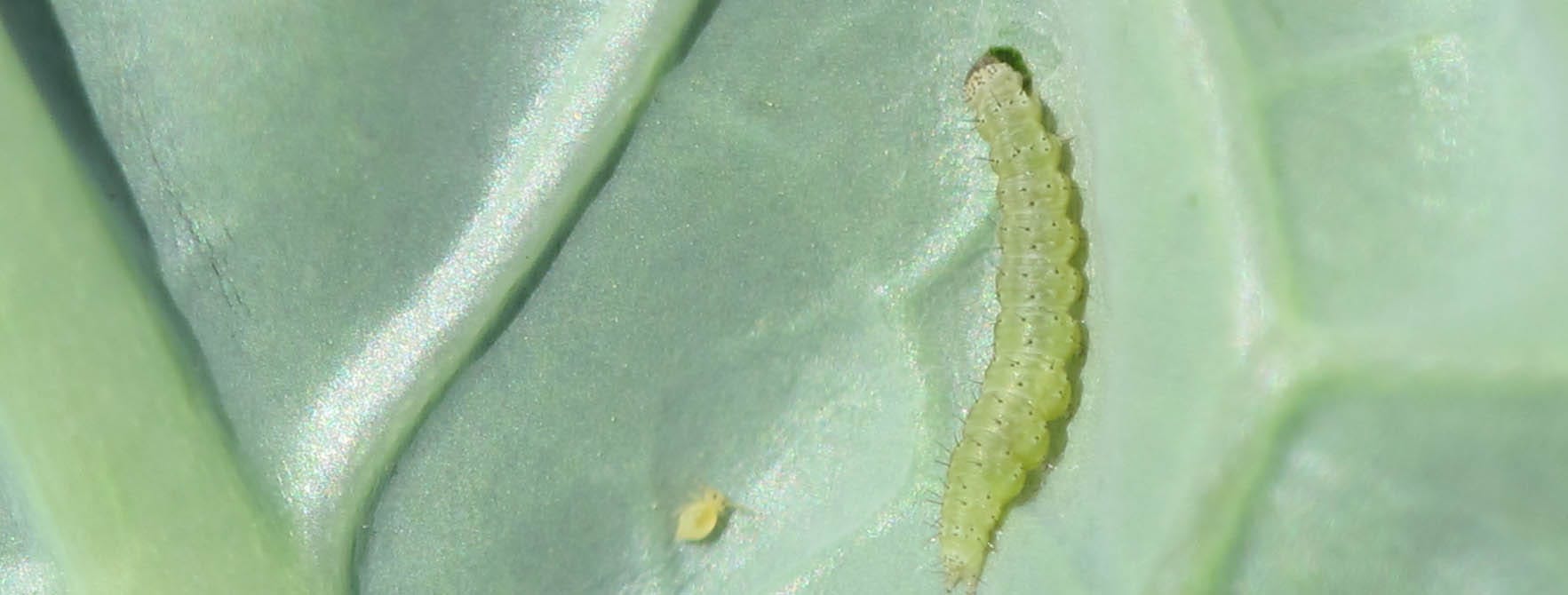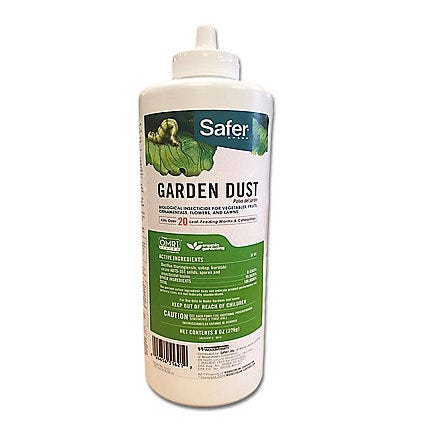
So... What's a Diamondback Moth Larvae?
Diamondback moth larvae are in the stage between hatching from the eggs until reaching adulthood. Larvae are light green in color and measure 1/4"-1/3" in length.
Adult diamondback moths are grayish in color with light diamond marks on its wings. They measure up to 1/2" in length. Eggs are round and yellowish white.
Reproduction Patterns of Diamondback Moths
Adult diamondback moths overwinter and in the spring, the females deposit their eggs on leaves. The eggs hatch in less than a week and the young larvae begin to feed, mining tunnels into the leaves of cabbage plants, broccoli, cauliflower, and other plants of the cabbage family.
Later, the larvae will eat holes in the leaves of those plants and eating parts of the plants' heads. This larval stage can last anywhere from 10 days to a month before they pupate.
After 5 to 15 days of pupating, the adult diamondback moth emerges ready to mate and deposit her eggs, continuing the cycle. Adults may live anywhere from 2 to 8 weeks and there are usually about 3 to 6 generations of diamondback moths in a season.
Diamondback Moth Larvae's Habitat
Diamondback moths can be found throughout the United States. Their favorite habitat is among gardens or fields of crucifers, including broccoli, cauliflower, cabbage, Brussel sprouts, and kale.
Symptoms of Diamondback Moth Larvae Damage
Holes in leaves and sections of crucifer heads that have been chewed are signs of possible diamondback larva infestation.
Results of Diamondback Moth Larvae Infestation
The heads of the crucifers may appear chewed and be unmarketable. Larvae may damage the buds of plants, resulting in stunted growth or poorly developed unmarketable crop produce.
Diamondback Moth Larvae Controls
What?
B.t. and pyrethrins are solutions that can be used to help control diamondback moth larvae. B.t. is a safe method of eliminating your garden or field of this pest without environmental concerns or harm to wildlife and beneficial insects. Ins
 ecticides containing pyrethrins can also be a beneficial method of controlling the diamondback moth larvae.
ecticides containing pyrethrins can also be a beneficial method of controlling the diamondback moth larvae.
How?
B.t. kills diamondback moth larvae, thereby preventing further damage. When the worm ingests the B.t., the B.t. causes the worm to cease feeding. It will stop feeding immediately and die within days of malnutrition.
B.t. can be made available in a spray, granular or dust. This product is very specific and only works on caterpillars and leaf feeding worms. It will not harm beneficial insects, children, pets or wildlife.
When?
B.t. is generally applied when it is a cooler time of day, preferably later in the afternoon or early in the evening since the product breaks down in sunlight and heat.
Safer® Brand offers a variety of diamondback moth larvae control products to help control and eliminate this garden pest and revive your plants. Please check out our diamondback moth larvae control products for more details about how they work and how, when, and where they should be applied.
It is recommended with any pesticide to test plants for sensitivity to the product. Spray a small section of the plant in an inconspicuous area and wait 24 hours before applying full coverage.
When applying pyrethrins to infected plants, follow all directions on the product labeling for safe and effective application. Do not spray plants in the peak of the day or when temperatures exceed 90°F.
Natural Predators
What?
Parasitic wasps, ladybugs, lacewings, spiders and birds are all natural predators of diamondback moth larvae and in some cases, the adult moth.
How?
Parasitic wasps, ladybugs, and lacewings will lay their eggs inside the diamondback larvae. Upon hatching the emerging larvae will feed on and kill the diamondback larvae, if it is not already dead. You may be able to attract parasitic wasps by planting nectar and pollen producing flora.
To aid the organic gardener, parasitic insects can be purchased through a commercial insect breeder. Make sure if you purchase these insects you have an actual garden insect infestation or you may notice the parasitic wasps, ladybugs and lacewings migrating to your neighbor's yard in search of food.
Birds and spiders prey on the adult moth. Birds can be attracted to the area with bird feeders, and hopefully, they will find they prefer the moths.
Once these garden helpers appear and attack the diamondback moth larvae and moths, you will start noticing a decline in the diamondback moth larvae on your plants.
When?
Most local greenhouses and garden centers can help you determine the right planting time for nectar and pollen producing plants to ensure that the pollen and nectar will be available when the wasps and lacewings arrive.
If using commercially produced parasitic insects, be sure to read and follow all instructions that accompany the product to find out when to disperse the insects on the plants.
Environmental Controls
What?
Floating row covers, rotation of crops, and removing plant debris are all methods that may help control diamondback moth infestations.
How?
Floating row covers can be used on top of the crucibles to protect them from the diamondback moths. These can be purchased at your local farm and garden center. Rotate crops, keeping the new type of crop far apart from where the infected plants had been. Remove any old plant or vegetative debris left over from the harvest.
When?
Check with your local farm and garden center to find out when to place the floating covers on the rows. Rotate crop after removing the infested crop. Remove any plant or vegetative debris left over after harvesting the crops in the field.
Use floating row covers after planting, but keep in mind you will need to hand pollinate the plants since pollinating insects will not be able to reach the plantings either.

